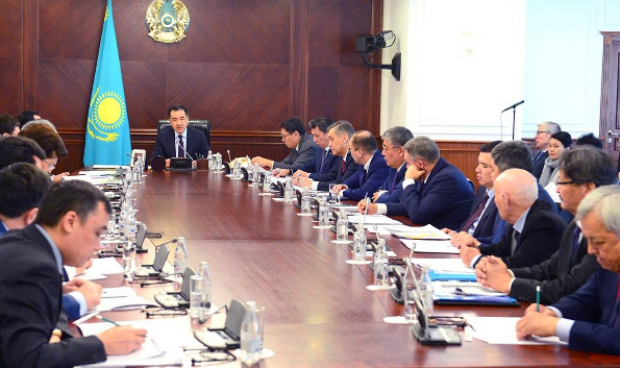Bakytzhan Sagintayev holds a meeting of National Commission on translation of Kazakh alphabet to Latin script

In Ukimet Uyi, the Prime Minister Bakytzhan Sagintayev held a meeting of the National Commission on the translation of the Kazakh alphabet into Latin script on March 2, 2018.
During the meeting, reports were heard about the work of the spelling, methodological, terminological working groups, as well as the working group on technical and information support. In addition, the Plan of measures for the phased transfer of the Kazakh alphabet to the Latin script up to 2025 and the rules for spelling on the basis of the alphabet in a new edition were considered.
"The Head of State amended the Decree "On translating the Kazakh alphabet from the Cyrillic to the Latin script." The new version received support from the public, linguists and took into account the recommendations of the Commission members. Now, in accordance with the President's instruction, it is necessary to continue the work in this direction," the Prime Minister Bakytzhan Sagintayev said.
Minister of Culture and Sports, A. Mukhamediuly, Minister of Information and Communications, D. Abayev, Minister of Education and Science, Y. Sagadiyev, Director of the State Enterprise Institute of Linguistics after A. Baitursynov, Y. Kazhybek, made presentations on the main directions of the translation to the Latin alphabet. First Deputy Chairman of the Nur Otan Party, M. Ashimbayev, the Deputy Prime Minister of Kazakhstan, E. Dossaev, Head of the Internal Policy Department of the Presidential Administration, A. Balayeva, Chairman of the Board of Kazakhstan Republican TV and Radio Corporation, Y. Karin and others took part in the discussion.
For reference: The National Commission is a consultative and advisory body under the Government whose main goal and task is to prepare and approve proposals for translating the Kazakh alphabet into Latin script, coordinating and monitoring the quality of work performance.
Deputy Chairman – Deputy Prime Minister, E. Dossaev, as well as representatives of the Administration of the President, the Nur Otan Party, the Parliament, universities, mass media, public organizations, famous scientists and public figures are included in the commission headed by Bakytzhan Sagintayev.
The translation of the Kazakh alphabet into Latin script until 2025 is supposed to be carried out in stages.
The first stage covers 2018-2020. During this period, preparatory work and measures will be carried out to improve the regulatory legal framework. Development of spelling rules for the new Kazakh alphabet on the basis of the Latin script, IT-applications for a text-based Latin alphabet recodifier are planned.
The second stage is 2021-2023. Organizational and methodological activities will be held during this period. Seminars and lectures, courses with the involvement of philologists and linguists will be organized to train teachers of centers and adults. Issuance of passports, identity cards of a citizen of the Republic of Kazakhstan and other documents in the state language on the basis of Latin graphics will be provided.
The third stage is 2024-2025. Translation of office work of local and central state bodies, state media and state printed publications into Latin script (in stages). Also, a phased transition of the organization of education to the Latin script.
Working groups of spelling, methodological, terminological, technical and information support were also created with the involvement of experts in the field of linguistics and IT technologies.
The spelling working group develops the rules of orthography and orthoepy of the Kazakh language on the Latin script;
The methodical working group develops methods of teaching and learning, as well as their gradual introduction into the educational system;
Terminological working group is intended for systematization of the terminological fund of the Kazakh language on the basis of Latin graphics;
The Working Group on Technical and Information Support will work to adapt Latin graphics to IT technologies and information spaces.
